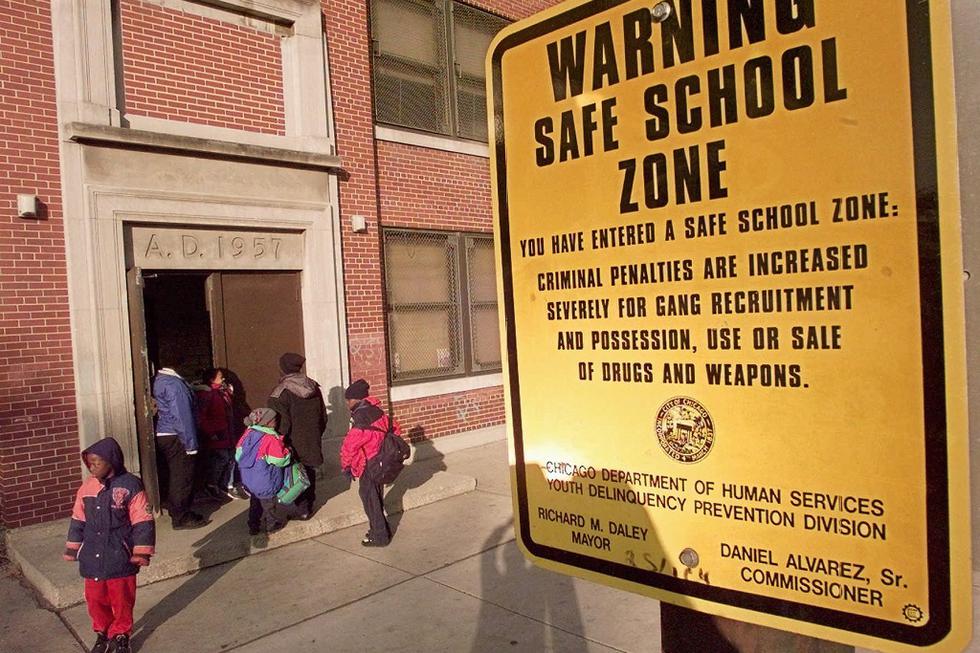The American Prospect By Anthony S. Bryk et al. Across the country, the war against public education proceeds apace, and in many states the anti’s are winning.
Forty-one years ago, in “A Nation at Risk” (1983), a blue-ribbon national commission decried “the rising tide of mediocrity” in public schools. The report’s rhetorically masterful opening salvo drew widespread attention to what otherwise would likely have been a file-and-forget document: “If an unfriendly foreign power had attempted to impose on America the mediocre educational performance that exists today, we might well have viewed it as an act of war.” “A Nation at Risk” made education a hot-button issue on the nation’s political agenda and turned the bashing of public schools into a national pastime.

As James Harvey, a senior staffer on the commission, pointed out years later, “The argument of wholesale school failure has been an essential bulwark of the effort to privatize public education by diverting public funds into school vouchers and unaccountable charter schools, particularly the scandal-plagued for-profit charter sector.” Fast-forward to 2024: “Public Schooling in America,” a survey of state policies nationwide, concludes that seemingly distinct attacks on public education—through expanding charter and voucher programs; cutting funds for public schools, while providing added support for homeschooling; censoring what educators can teach and students can learn—are in fact intertwined, as “Christian nationalism and the extreme right have become mainstream in many states.” The report grades states according to how well they safeguard public schools.
Seventeen states, almost all of them solidly Republican, received a grade of F. An increasing number of states (seven, in 2023 alone) have launched new voucher plans, often with little if any oversight. Money that previously went to public schools is being siphoned off to vouchers.
Count Donald Trump among the public-school haters. In his 2017 inaugural address, he blasted “an education system flush with cash but which leaves our young and beautiful students deprived of all knowledge.” The drumbeat of criticism has generated widespread lack of confidence in public education.
A 2023 Gallup poll found that, while just over three-quarters of parents report that they’re satisfied with their oldest child’s education, 41 percent believe the schools are doing a good job—that’s fewer than at any time since 2000. , a deep dive into Chicago’s public schools, delivers a powerful rejoinder to the naysayers. A district that used to be ridiculed has evolved into a model for big-city school systems.
In autumn 1987, Bill Bennett, then the U.S. secretary of education, paid a whirlwind visit to Chicago.
He didn’t like what he saw: “You’ve got close to educational meltdown here in Chicago ...
Is there a worse case? You tell me.” The fact that Chicago’s public schools were a disaster area wasn’t news in the Windy City—half of the district’s high schools ranked in the bottom 1 percent nationwide; nearly half of the students dropped out before graduating. Some schools were danger zones: “When I took my oldest daughter to school,” Florence Cox, Chicago PTA president, said in a documentary, “I actually felt that if I left my daughter there that day I would not see her ever again alive.
” Almost a decade before Bennett’s visit, fiscal corruption prompted state lawmakers to fire the school board and create a body to oversee the system’s budget. These failures had been the city’s dirty little secret, but the “worst in the nation” label went national. Naysayers pointed to Chicago as exhibit number one for the miseducation of America’s children.
Bennett’s “gotcha” infuriated Chicagoans, catalyzing a reform effort that had already been ticking along, and since then Chicago public schools have become markedly better. Black and Latino third graders from low-income families have been, at least according to 2017 data, outperforming their counterparts elsewhere in the state. Graduation rates rose to 84 percent in 2023, within hailing distance of the national average.
In 2022, three-fifths of high school graduates enrolled in college immediately upon graduating high school, an increase from previous years, countering the national trend of declining college attendance during COVID; more of them are earning degrees than in the past. This track record is among the best urban school systems in the nation. The hunt for a panacea—what historians David Tyack and Larry Cuban memorably labeled “tinkering toward utopia”—has long been a fixture of public education.
But that hunt is doomed to failure, for transforming a system that’s as intricate as a Swiss watch is necessarily a complex task. Chicago is a cauldron of racial and ethnic politics, and simple explanations for the schools’ success, like the city’s changing demographics and the growth of charter schools, do not capture the dynamics of change. Many of the best ideas for change have emerged from the bottom up, as initiatives launched at one site are brought to scale by networks of teachers, principals, and community leaders.
At the same time, pressure from civic and business organizations helped to transform the management of the system. The federal government also played a notable role, as Chicago, like school systems nationwide, had to adjust to the “no child left behind” regime of high-stakes, test-based accountability for student achievement. These structural changes, and the policies and practices that they generated, have not been driven by a master plan.
Rather, they have emerged from a continuous improvement, “tortoise beats hare” approach. That’s the main takeaway from . The otiose central bureaucracy, 3,000 administrators strong, was broadly condemned as a major roadblock to reform.
A 1988 state law shifted decision-making power away from the bureaucracy to neighborhood councils. Parents and community members were given significant responsibility for managing their school, including hiring the principal and weighing in on the budget. Across the 600-plus schools in the district, the impact of that measure was uneven—some councils worked well while others struggled, and there was no mechanism to support those that needed help.
What’s more, there was no buck-stops-here, system-wide accountability. To address these weaknesses, a second round of state legislation gave Chicago’s mayor the power to appoint the school board and hire a “chief executive officer,” changes that supplemented but didn’t supplant community control. An emphasis on teacher training, led by the central office, was a significant result of this shift.
In short, “a parochial system [was opened] to new energies, new pressures, new people, and new ideas.” The Chicago story is not a straightforward march-to-success narrative. There have been setbacks along the way, including prolonged teacher strikes, fights over school closures, administrative churn, and high-profile CEO misconduct.
This shouldn’t come as a surprise—who could reasonably anticipate smooth sailing in the country’s fourth-largest school system, a massive institution nested in a controversy-addicted city? Remarkably, the public schools have withstood these challenges, as graduation rates and other measures of accomplishment have continued their steady rise. Nor has the system lost its penchant for evidence-driven changes. The most significant example is the ongoing expansion of early education, with its demonstrated promise of shifting the arc of children’s lives, auguring well for their success.
A commitment to experimentation has prompted the system to partner with the University of Chicago Education Lab in testing promising innovations, such as intensive math tutoring for ninth and tenth graders who were mired amid long division and fractions; and a summer internship program that has given students the soft skills they would need in the world of work. The district has a long way to go, especially in closing the gap between poor and minority students and the rest of the school population. Still, if Bill Bennett were to make a return visit to Chicago, he would be singing a very different tune, if he knew one.
The Chicago school system is hardly a unique success story. , which I co-authored with colleagues from the Learning Policy Institute, shines a light on three midsized districts—Union City, New Jersey; Roanoke, Virginia; and Union, Oklahoma—where a majority of the students are racial and ethnic minorities from low-income families. Unlike celebrated communities like Lexington, Massachusetts, and Palo Alto, California, these districts operate beneath the radar, but they merit a shout-out: In each instance, the graduation rate has steadily increased, while the opportunity gap has essentially become a thing of the past.
A generation or two ago, each of these districts was a basket case, with below-par student achievement and dropout-factory high schools. Union City’s schools were so wretched that New Jersey was a hair’s breadth away from taking them over. Their progress didn’t come from a cookbook; instead, it emerged from a diagnosis of the district’s particular needs and a step-by-step, research-driven approach to addressing them.
In Union City, an almost entirely Latino school system, school leaders devised a nationally renowned prekindergarten-through-high school bilingual program. Roanoke focused on the trauma its students suffered from, engaging everyone from the superintendent to the bus drivers in the effort to recognize and respond effectively. Union developed a STEM program for all students, from kindergarten through secondary school.
Each district had other priorities, such as a nationally honored music program in Roanoke and world-class early education in Union and Union City, but none of them succumbed to faddishness. These school systems all aimed for 100 percent graduation. That’s not a rhetorical flourish—it’s an aspiration with profound implications.
The educators didn’t blame the students who dropped out; instead, they looked for underlying explanations. Sometimes, as with students who couldn’t handle high school math, the problem could be traced to how arithmetic was taught in elementary school. Chicago enrolls about 23 times as many students as these districts.
Some of its challenges are different, and so are its responses. But these districts have one big thing in common—a bedrock commitment to steady improvement, building on earlier accomplishments while forever striving to do better. There’s no reason why every school district cannot do the same.
.



















